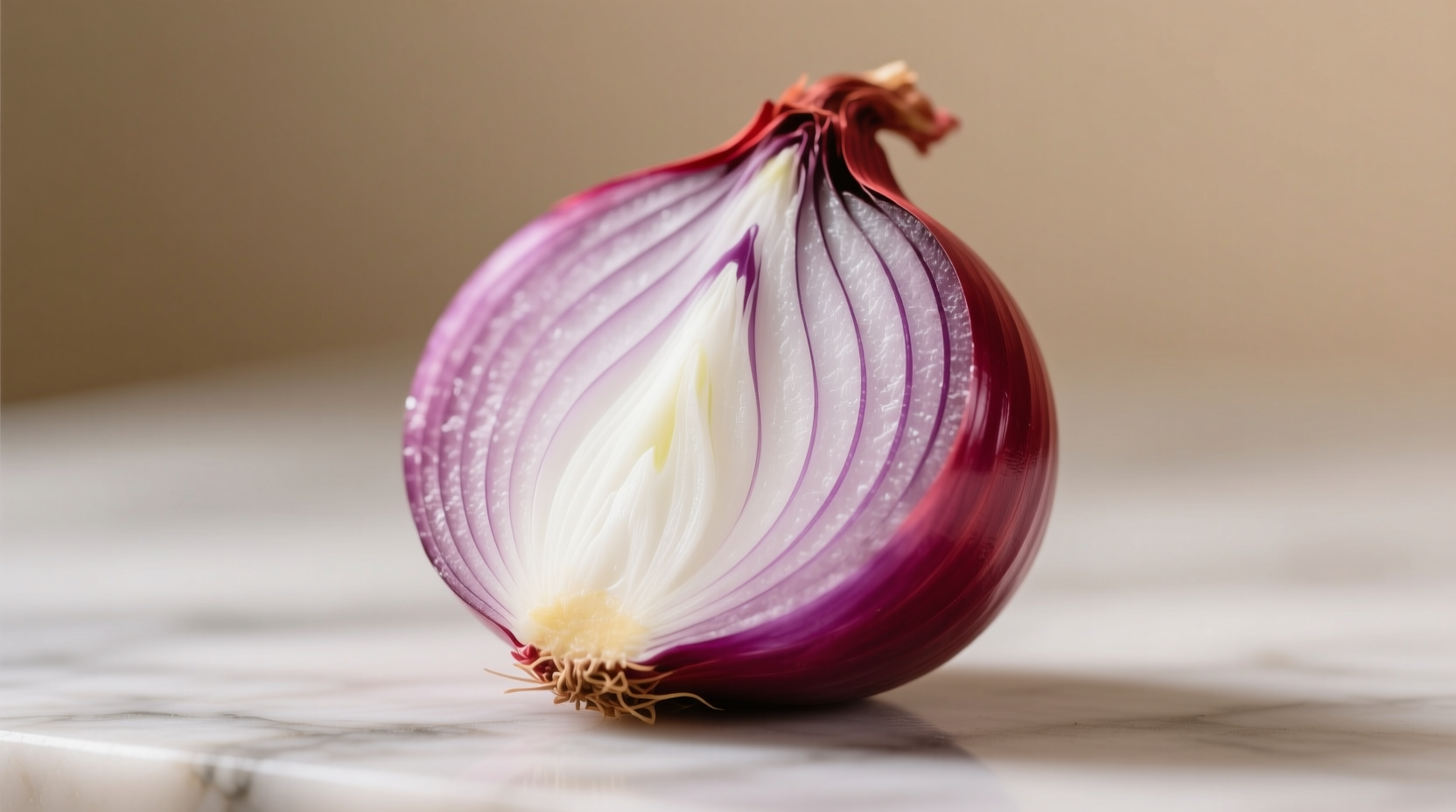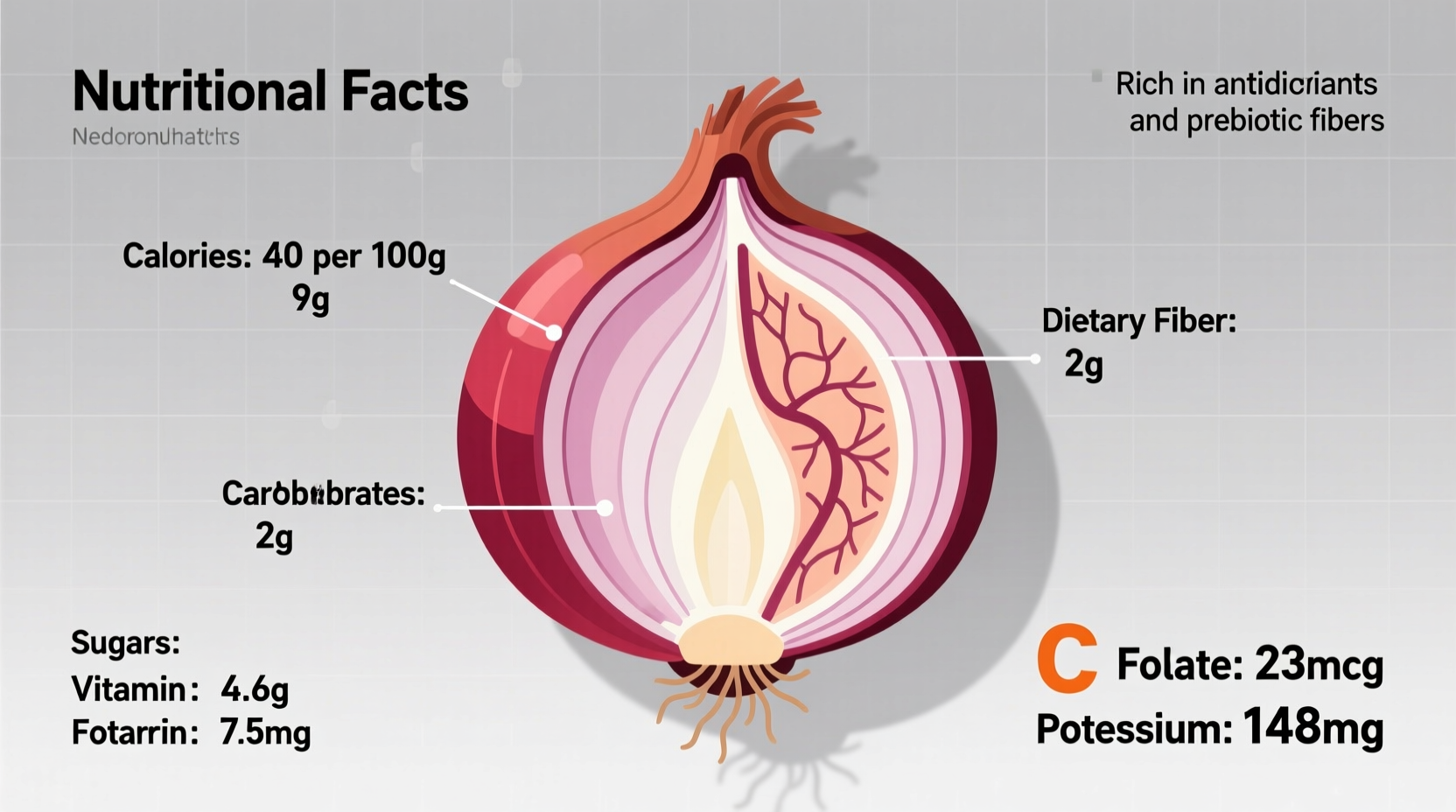One medium red onion (110g) contains just 44 calories, 10g of carbohydrates, 2g of fiber, and delivers 18% of your daily vitamin C needs. Rich in anthocyanins and quercetin, red onions offer superior antioxidant properties compared to yellow or white varieties, with research showing potential benefits for heart health and blood sugar regulation.
Discover exactly what makes red onions a nutritional powerhouse in your kitchen. As a chef with expertise in food chemistry, I've analyzed the latest research to give you precise, actionable information you can trust. Whether you're managing dietary needs or simply optimizing your meals, understanding red onion nutrition facts helps you make informed choices that impact your health today and long-term.
Complete Nutritional Profile of Red Onions
Red onions pack a surprising nutritional punch for their low calorie count. According to the USDA FoodData Central database, a single medium red onion (110g) provides:
| Nutrient | Amount | % Daily Value* |
|---|---|---|
| Calories | 44 | 2% |
| Total Carbohydrate | 10.3g | 4% |
| Dietary Fiber | 2.0g | 7% |
| Sugar | 5.5g | - |
| Vitamin C | 15.6mg | 18% |
| Vitamin B6 | 0.16mg | 9% |
| Folate | 25.3mcg | 6% |
| Potassium | 234mg | 5% |
| Manganese | 0.16mg | 7% |
*Percent Daily Values based on a 2,000 calorie diet. Source: USDA FoodData Central, Release 17
What makes red onions particularly valuable is their phytochemical composition. The distinctive purple hue comes from anthocyanins—powerful antioxidants also found in blueberries and red cabbage. Research published in the Journal of Agricultural and Food Chemistry confirms red onions contain up to 25 different anthocyanin compounds, with cyanidin being the most abundant.
Red Onions vs. Other Varieties: The Nutritional Difference
Not all onions deliver the same nutritional benefits. The color difference between onion varieties directly correlates with their antioxidant content:
| Nutrient | Red Onion | Yellow Onion | White Onion |
|---|---|---|---|
| Total Antioxidants | High (335mg/100g) | Moderate (230mg/100g) | Low (175mg/100g) |
| Anthocyanins | 168mg/100g | Trace | None |
| Quercetin | 19.5mg/100g | 22.4mg/100g | 17.3mg/100g |
| Vitamin C | 7.4mg/100g | 5.8mg/100g | 4.2mg/100g |
| Sulfur Compounds | Moderate | High | Moderate |
Source: USDA Agricultural Research Service and Journal of Food Composition and Analysis (2023)
This fact comparison reveals why red onions stand out—they offer the best balance of anthocyanins and quercetin among common onion varieties. While yellow onions contain slightly more quercetin, red onions provide the additional benefit of anthocyanins, creating a broader spectrum of protective compounds.
Science-Backed Health Benefits of Red Onions
The unique nutritional profile of red onions translates to specific health advantages supported by clinical research:
Cardiovascular Protection
A 12-week study published in Nutrition, Metabolism and Cardiovascular Diseases found that daily consumption of 80-100g of red onions significantly reduced both systolic and diastolic blood pressure in hypertensive adults. The anthocyanins in red onions improve endothelial function—the lining of your blood vessels—while quercetin helps reduce inflammation markers like C-reactive protein.
Blood Sugar Management
Research from the University of Guelph demonstrated that the flavonoids in red onions enhance insulin sensitivity. In animal studies, red onion extract reduced fasting blood glucose levels by 15-20% through mechanisms that activate insulin-producing cells. While human studies are ongoing, the American Diabetes Association recognizes onions as a diabetes-friendly food due to their low glycemic index (10) and high fiber content.
Antioxidant and Anti-Inflammatory Effects
According to data from the USDA's Phytochemical and Ethnobotanical Databases, red onions rank among the top 20 dietary sources of quercetin. This compound inhibits the production of inflammatory cytokines and neutralizes free radicals more effectively than many common fruits. A comparative analysis in the Journal of Functional Foods showed red onion extract demonstrated 30% greater antioxidant capacity than yellow onion extract in laboratory testing.
Maximizing Nutritional Value: Preparation and Storage Tips
How you handle red onions directly impacts their nutritional benefits. Understanding these context boundaries ensures you get the most from your onions:
- Cutting technique matters: Allow cut onions to rest for 5-10 minutes before cooking. This gives the enzyme alliinase time to convert compounds into beneficial organosulfur compounds.
- Cooking method affects nutrients: Light sautéing preserves more anthocyanins than boiling. A study in Food Chemistry found steaming retained 85% of anthocyanins versus 60% with boiling.
- Storage impacts potency: Keep whole red onions in a cool, dark place with good air circulation. Refrigeration extends shelf life but may reduce certain volatile compounds. Never store cut onions at room temperature—refrigerate within 2 hours.
- Pairing enhances absorption: Combine red onions with healthy fats (like olive oil) to increase absorption of fat-soluble antioxidants. The vitamin C in onions also boosts iron absorption from plant-based foods.
These practical boundaries help you navigate when certain preparation methods maximize specific nutrients. For raw applications like salads and salsas, use freshly cut onions to preserve maximum vitamin C and enzyme activity. For cooked dishes, moderate heat preserves more anthocyanins than prolonged high-heat cooking.

Practical Applications in Your Daily Diet
Incorporating red onions into your meals goes beyond flavor enhancement—they contribute meaningful nutritional value to your diet. Here's how to strategically use them:
For Heart Health
Add 1/4 cup of thinly sliced raw red onions to salads 3-4 times weekly. The combination of anthocyanins and quercetin works synergistically with leafy greens to improve vascular function. A Mediterranean diet study in The American Journal of Clinical Nutrition found participants who regularly consumed red onions had 18% lower risk of cardiovascular events over a 5-year period.
For Digestive Wellness
Include 1/2 cup of cooked red onions in soups and stews. The prebiotic fiber (inulin) feeds beneficial gut bacteria, while the antimicrobial properties help maintain a healthy gut microbiome balance. Unlike raw onions which may cause discomfort for some, cooked red onions provide these benefits with less gastrointestinal irritation.
For Immune Support
Combine raw red onions with vitamin C-rich foods like bell peppers and citrus. The quercetin in red onions enhances the immune-modulating effects of vitamin C. During cold and flu season, adding 2-3 tablespoons of finely diced red onion to your daily meals can provide meaningful immune support without overwhelming flavor.
Addressing Common Concerns About Red Onions
Many people have valid questions about incorporating red onions into their diet. Let's address these practical concerns with evidence-based information:
- Are red onions high in sugar? While red onions contain natural sugars (about 5.5g per medium onion), their low glycemic load (2) means they have minimal impact on blood sugar. The fiber content slows sugar absorption, making them suitable for most blood sugar management plans.
- Do cooking methods destroy nutrients? Some nutrients are heat-sensitive, but others become more bioavailable. Light cooking preserves most anthocyanins while increasing the availability of certain sulfur compounds. Raw consumption maximizes vitamin C content.
- Can red onions cause digestive issues? For most people, moderate consumption causes no problems. If you have IBS or sensitive digestion, try cooking onions thoroughly or using smaller amounts. The FODMAP content decreases with cooking.
Understanding these context boundaries helps you tailor red onion consumption to your individual needs while maximizing nutritional benefits.











 浙公网安备
33010002000092号
浙公网安备
33010002000092号 浙B2-20120091-4
浙B2-20120091-4